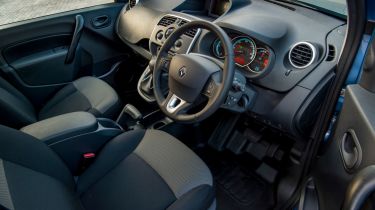Renault Kangoo E-TECH electric (2011-2021) interior, dashboard & comfort
The Renault Kangoo E-TECH is a van, and the quality of the cab doesn't let you forget that fact

If there’s one thing the Renault Kangoo E-TECH does well, it’s putting function over form. While the running gear could be considered futuristic, the boxy lines outside are unmistakably van-like, and as the original Kangoo arrived more than a decade ago in 2007, it’s not very modern-looking. It was facelifted in 2013, and the electric version’s nose was tidied up by placing the charging socket behind the large Renault badge.
But the van’s large unpainted plastic bumpers and rubbing strips demonstrate that the Kangoo is designed to deal with a busy work life. Inside, there’s plenty of hard plastic on show, and the switchgear feels a little flimsy in places. The Kangoo is a two-seater, so there’s decent space up front, while storage comprises an overhead shelf, decent door bins and storage on top of the dash, although the glovebox is compromised by the position of the fuse box on the left side.
Renault Kangoo E-TECH electric dashboard
The Kangoo's dashboard will be familiar to anybody that has driven a Renault Clio or Megane from the past decade. The same switchgear is used here, although the addition of a green and blue power meter in place of a rev counter reminds you that this is an electric vehicle. There’s a gear selector on the dashboard, while the orange digital display between the dials shows which drive mode you’re in. The steering wheel is flanked on the right by a set of stereo controls, or you could use the flimsy push buttons on the dashboard instead.
However, we’d recommend upgrading to Renault’s seven-inch R-Link infotainment system. It adds TomTom sat-nav (with a 12-month subscription to its live services) and greater functionality, including an eco driving monitor, Bluetooth and downloadable apps. If you can’t quite stretch to this system, Renault’s R&Go setup allows you to connect your smartphone or tablet to use as an infotainment system with nav, and if you download Renault’s dedicated app, it allows you to monitor how economically you’re driving, too.
Equipment, options and accessories
The standard Kangoo E-TECH is based on Business trim, so it comes with a rudimentary amount of standard kit. There are electric windows and mirrors, a height-adjustable steering wheel and seat, deadlocks, a stereo, Bluetooth and 12v socket in the cab.
Go for a standard van body, and you get a single sliding side door, but the Kangoo Maxi has a pair of sliding doors, which add windows if you choose the Crew Van version. Other useful standard kit the Kangoo E-TECH gets over the standard diesel van is a pre-heating timer (although you have to add the optional R-Link multimedia system for this to work) and wheel trims instead of basic steel wheels.
There's also the Business+ model, which Renault says features over £1,000 worth of equipment for just £600 more than the Business version's list price. Metallic paint, body-coloured front and rear bumpers, powered folding door mirrors, a central armrest, an overhead parcel and a practical rubber floor covering for the load area all thrown in, while the Business+ also gets one-touch electric front windows and rear parking sensors.
Options are focused around the load area. You can add a plywood lining to help prevent scratches, while there’s a mesh bulkhead option that adds a swivelling section which rotates around the driver to create another 0.6 cubic metres of load space where the passenger seat would normally be. Other options include windows for the rear doors, rear parking sensors and body-coloured bumpers.
Infotainment, apps & sat nav
The two-speaker stereo is pretty weedy, but it does have a USB connection – so you can use a smartphone with Renault’s R&Go apps – as well as an auxiliary socket and Bluetooth phone connection. We recommend optional R-Link infotainment system. It adds a useful TomTom sat nav, and extra functions to help you keep an eye on the Kangoo’s electric system. This includes an Eco Driving Coach, which provides information on how you’re driving and gives pointers on where you can improve to boost driving range.
It’s not the most intuitive system to use, but it’s easy enough to navigate once you’re accustomed to it. There’s also a voice control system offered – simply press the button on the steering wheel and speak a command, and the system will kick into action. Another issue with R-Link is that it relies on Renault’s own apps to provide additional functions, and there’s no Apple CarPlay or Android Auto available.



